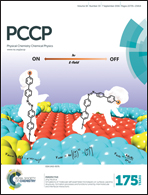Direct observation of slow intersystem crossing in an aromatic ketone, fluorenone
Abstract
Direct measurements of Single vibronic Level InterSystem Crossing (SLISC) have been performed on the fluorenone molecule in the gas phase, by time resolved photoelectron and photoion spectroscopy. Vibronic transitions above the S1 nπ* origin were excited in the 432–420 nm region and the decay of S1 and growth of T13ππ* could be observed within a 10 ns time domain. The ionization potential is measured as 8.33 ± 0.04 eV. The energy of the first excited triplet state of fluorenone, T1 has been characterized directly at 18 640 ± 250 cm−1. The internal conversion of S1 to S0 is found to amount to ∼15% of the population decay, thus ISC is the dominant electronic relaxation process. ISC, although favored by the S11nπ*–T13ππ* coupling scheme, is 3 orders of magnitude less efficient than in the similar molecule benzophenone. Thus, the planarity of the fluorenone molecule disfavors the exploration of the configuration space where surface crossings would create high ISC probability, which occurs in benzophenone through surface crossings. The time evolution of S1 fluorenone is well accounted for by the statistical decay of individual levels into a quasi-continuum of T1 vibronic levels.


 Please wait while we load your content...
Please wait while we load your content...